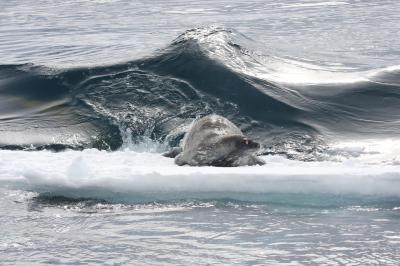NOAA's Fisheries Service scientists studying the cooperative hunting behavior of killer whales in Antarctic waters observed the animals favoring one type of seal over all other available food sources, according to a study published in the journal Marine Mammal Science.
Researchers Robert Pitman and John Durban from NOAA's Southwest Fisheries Science Center in La Jolla, Calif., observed killer whales hunting in ice floes, off the western Antarctic Peninsula during January of 2009. While documenting the whales' behavior of deliberately creating waves to wash seals off ice floes, the researchers noticed Weddell seals as their primary target, despite the availability of other prey species, particularly the more abundant crabeater seals.

Killer whales generate a wave designed to knock the resting Weddell off an ice floe near the western Antarctic Peninsula.
(Photo Credit: Robert Pitman/NOAA)
"These killer whales would identify and then attack Weddell seals almost exclusively, even though they made up only about 15 percent of the available seal population," said Pitman.
Killer whales creating waves to wash seals off ice floes in Antarctica had previously been observed only a handful of times. The whales, sometimes as many as seven abreast, charge the ice floe creating a wave that either washes the seal off the ice or breaks the ice into smaller pieces and more vulnerable to another attack. A previous study involving the authors suggested that this very distinctive killer whale population, which they refer to as "pack ice killer whales," is a separate species.

A killer whale "spy-hops" to identify a Weddell seal resting on an ice floe off the western Antarctic Peninsula. The whale will notify other killer whales in the area so they can coordinate a wave to wash the seal off the floe.
(Photo Credit: Robert Pitman/NOAA)
Once the seal was washed off the ice, the killer whales worked as a group to keep it away from hauling onto the safety of another ice floe. The whales seemed to try and confuse the seal by causing turbulence in the water with their flukes and blowing bubbles under the water through their blowholes.
Away from the ice, the whales attempt to tire and eventually drown the animal by pulling it under water by its hind flippers. Eventually the seal succumbs to exhaustion and is usually divided up among the pod members underwater. In most cases, little of the seal's remains float to the surface, but in one instance the carcass rose to the surface and appeared to have been methodically skinned and dismembered before being eaten.

A Killer Whale circles an ice floe with a resting Weddell seal off the western Antarctic Peninsula. Researchers found the killer whales hunting in pack ice (pack ice killer whales) preferred Weddell seals to all other available prey.
(Photo Credit: Robert Pitman/NOAA)